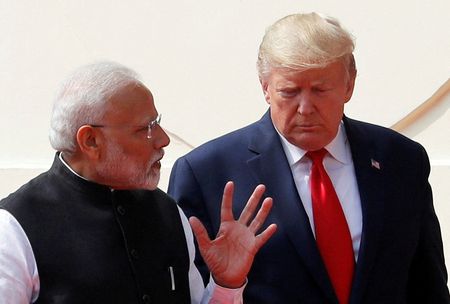By Chuck Mikolajczak
NEW YORK (Reuters) -The dollar hardly budged on Thursday as it held in a tight range after a sharp drop earlier in the week, with investors seeking clarity on expected tariffs from U.S. President Donald Trump and the path of interest rates from global central banks.
The dollar is down more than 1% on the week, largely due to a sharp drop on Monday as widely expected tariff announcements from Trump failed to materialise after his inauguration. The dollar has moved only slightly in the sessions since.
Trump will speak remotely to the World Economic Forum on Thursday in Davos, Switzerland, and hold a discussion with business leaders scheduled for 11 a.m. Eastern time (1600 GMT).
“We don’t have any truly certain information to go off of, so until we have a definitive answer, we’ll continue to see a little more volatility,” said David Eng, Investment Adviser at Sonora Wealth Group in Vancouver.
“It seems like the markets are more concerned about rate cuts and any kind of greater indicator that there’ll be more rate cuts.”
Investors are awaiting a host of policy decisions from global central banks over the next week, with the Bank of Japan widely expected to raise interest rates at the end of a two-day meeting on Friday.
Rate decisions from the U.S. Federal Reserve and European Central Bank (ECB) are scheduled for Wednesday and Thursday of next week, respectively.
The dollar index, which measures the greenback against a basket of currencies including the yen and the euro,rose 0.07% to 108.34, with the euro down 0.12% at $1.0394.
The greenback tumbled 1.2% on Monday in its steepest one-day slide since November 2023, as Trump’s first day in office came with a slew of executive orders but no tariffs.
The dollar had climbed to a more than two-year high of 110.17 on Jan. 13 on a resilient U.S. economy and expectations of widespread U.S. tariffs, which could weigh on the currencies of other countries.
Data on Thursday showed new applications for U.S. unemployment benefits rose marginally last week, suggesting that solid job growth likely continued in January.
Markets are pricing in a nearly 96% chance the ECB will cut rates at its meeting next week, with recent comments from the central bank’s policymakers indicating a cut was likely.
Trump said this week that his administration was looking into imposing a 10% tariff on goods imported from China on Feb. 1, after he earlier said Mexico and Canada could face levies of around 25% by that date. He also promised duties on European imports, without providing details.
On Monday Trump signed a trade memo ordering federal agencies to review a range of trade issues by April 1, which many market participants believe will be a key date in revealing tariff plans.
Sterling was unchanged at $1.2316. The Mexican peso strengthened 0.48% versus the dollar at 20.42.
The Canadian dollar edged down 0.01% to C$1.44 per dollar. Canada’s central bank is largely expected to cut rates at its policy meeting next week after inflation data earlier this week came in below its target rate of 2%.
The Japanese yen firmed 0.08% against the greenback to 156.38 per dollar. The dollar strengthened 0.15% to 7.292 versus the offshore Chinese yuan.
China announced plans on Thursday to channel hundreds of billions of yuan of investment from state-owned insurers into shares.
(Reporting by Chuck Mikolajczak; editing by Mark Heinrich)








